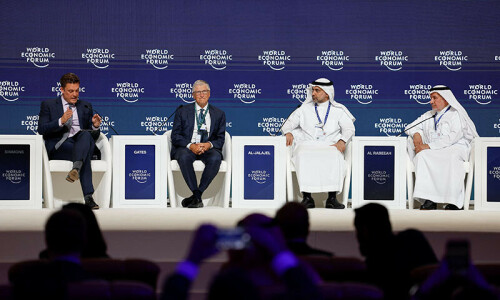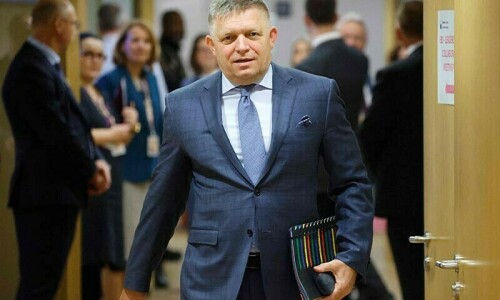During the last fiscal year ending in June 2023, Pakistan earned $35.2 billion through exports of goods and services. Out of this, a significant $8.3bn, or 23.7 per cent of the total, came from the US, according to the State Bank of Pakistan (SBP). During the same year, the country also earned $2.6bn, or 7.5pc of the total exports, from China.
This vast gap in the share of the world’s number one and number two economies in Pakistan’s export earnings may narrow in coming years as Islamabad takes concrete steps to boost exports to China. Pakistan is also making efforts to increase its exports to Afghanistan and Iran.
As for normalising trade with India, that depends on how soon the two countries re-engage in confidence-building measures. Foreign Minister Ishaq Dar recently said that the government had engaged all stakeholders in consultations to explore the possibility of resuming trade ties with India.
In today’s world of ever-rising trade costs with faraway countries, Pakistan clearly needs to trade more with its four neighbours — China, Afghanistan, Iran, and India. Unfortunately, for a long period, its trade with India and Iran has remained small due to political and diplomatic reasons in case of the former, and US sanctions in the case of the latter.
Government must walk a tightrope in trying to tap into trade opportunities with neighbouring states without tarnishing Western trade ties
During the last fiscal year, Pakistan’s goods exports to India and Iran totalled just $0.3m and $28,000, respectively. In Afghanistan’s case, Pakistani exports are currently on the decline. According to SBP, goods exports to Kabul slipped to $522m in the last fiscal year from $553m a year earlier. Moreover, in 8MFY24, the export earnings from Afghanistan fell to $320m from $346.5m in 8MFY23.
To maximise the benefits of economies of trade, Pakistan now needs to pursue a “look towards Asia” approach, focusing on neighbours and development partners in the Gulf Cooperation Council — Kuwait, Qatar, Saudi Arabia, and the United Arab Emirates.
This would also be a practical acknowledgement of the rising Asian share in the global economy and growing intra-Asian trade. However, to redirect merchandise exports, Islamabad must gradually shift from the West to the East.
There are three main reasons for this: First, it is practically impossible for exporters to immediately replace their old and large Western trade partners with Asian partners.
Second, as Pakistan depends on the International Monetary Fund (IMF) for frequent external borrowings, it is strategically unwise and unviable to speedily reduce its presence in Western markets.
In the last fiscal year, Pakistan’s goods exports to India and Iran totalled just $0.3m and $28,000, respectively, while exports to Afghanistan fell to $522m from $553m
Third, there is no harm in allowing imports from America and Europe and foreign investment from the Western world. The presence of American and European companies in the country influences our export policy. Hence, we see our leadership mostly engaged in balancing Pakistan’s trade and investment policies to tap the potential of intra-Asia trade without weakening the existing trade ties with the West.
Both the US and the European Union occasionally offer Islamabad some trade concessions and preferential treatment to our exporters (after extracting the due geopolitical and geostrategic price, of course). This factor also influences — and should be allowed to influence — the pace of any shift in the direction of trade.
Iran’s President Ebrahim Raisi’s recent visit to Pakistan was partially aimed at signalling to its arch-foe Israel that Tehran and Islamabad are “inseparable.” However, its primary purpose was to explore avenues of bilateral trade, investment, and cooperation in the fields of science and technology.
Media reports suggest that Saudi Crown Prince Muhammad Bin Salman may also visit Pakistan. In mid-April, Saudi Foreign Minister Prince Faisal Bin Farhan Al-Saud came to Islamabad and showed a keen interest in Pakistan’s viable projects for possible Saudi foreign investment. All the promised Iranian and Saudi investment in Pakistan is for medium to long-term development.
But the visit of Iranian President Mr Raisi, followed by the visit of the Saudi foreign minister, would surely help Pakistan enhance goods and labour exports to Saudi Arabia, curb smuggling through Pak-Iran borders, and accelerate bilateral trading immediately. These topics were not only discussed with the visiting dignitaries, but they also gave necessary assurances.
Pakistan’s merchandise exports to Saudi Arabia are already on the rise. In the last fiscal year, goods’ exports to Saudi Arabia totalled $503.4m, up from $420.4m a year earlier. And, in 8MFY24, export earnings from Saudi Arabia have already reached the $443m mark.
According to the SBP, during 9MFY24, Pakistan’s current account deficit shrank to only $508m from $4.05bn in the same period last year. This was possible both due to a big rise in exports and an even bigger fall in imports — a slight increase in remittances played a tiny role.
But Pakistan will have to lift all curbs on imports as soon as it formally enters negotiating a large $7bn to $8bn, three-year IMF loan. This means that the trade deficit in goods would start growing again. Selling more export goods to neighbouring countries could be a good strategy to boost our exports at that crucial time.
Lately, the share of food items in our overall goods exports has grown steadily — directing food exports towards neighbouring countries is obviously a lot easier than shipping them to faraway countries.
Published in Dawn, The Business and Finance Weekly, April 29th, 2024















































Dear visitor, the comments section is undergoing an overhaul and will return soon.